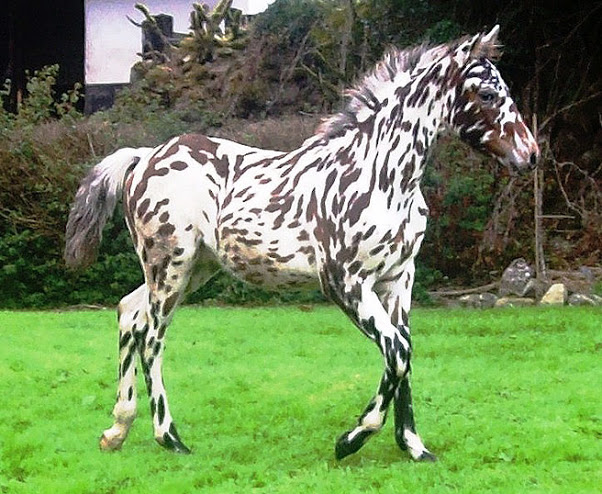
The Knabstrupper horse, with its distinctive coat pattern and rich history, stands as a testament to the enduring connection between humans and these magnificent creatures. Known for their striking appearance and versatile nature, Knabstruppers have carved a unique niche in the equine world. From their intriguing origin to the advantages and disadvantages of ownership, the story of the Knabstrupper horse is a fascinating journey through time.
Origins and Evolution
The Knabstrupper horse’s story begins in Denmark during the early 18th century. Originating from the esteemed Frederiksborg breed, the Knabstrupper breed emerged through selective breeding and a bit of genetic chance. A mare with an eye-catching leopard-spotted coat gave birth to a stallion named “Flaebehoppen,” who passed on his distinctive coat pattern to subsequent generations. This serendipitous event led to the development of the Knabstrupper breed.
During the 19th century, Knabstruppers gained popularity as riding and carriage horses. Their striking appearance made them favorites among royalty and aristocracy, further cementing their status as a coveted equine breed. However, their numbers dwindled over the years due to the ravages of war and changing equestrian trends.
Advantages of Owning a Knabstrupper Horse
Unique Aesthetic
The most obvious advantage of owning a Knabstrupper is its breathtaking coat pattern. The spots and splashes of color are a visual delight, making these horses stand out in any setting. Whether in the show ring or on a trail, Knabstruppers are bound to turn heads and start conversations.
Versatility
Knabstruppers are known for their versatility. They excel in various disciplines, including dressage, jumping, events, and driving. This adaptability makes them suitable for both competitive riders and leisure enthusiasts. Their calm temperament and willingness to learn make them a great choice for riders of different skill levels.
Strong Constitution
Knabstruppers often possess a robust constitution, inherited from their Frederiksborg ancestors. This resilience can be advantageous in various riding environments, from demanding competitions to long trail rides.
Disadvantages of Owning a Knabstrupper Horse
Health Concerns
While the leopard-spotted coat is visually stunning, it is associated with a genetic predisposition to certain health issues, including skin problems and sun sensitivity. Owners must take extra precautions to protect their Knabstruppers from prolonged sun exposure and potential skin irritations.
Limited Breeding Pool
Due to the breed’s relatively small population, finding a suitable Knabstrupper for purchase or breeding might be challenging. Limited availability can affect the ability to find a horse that matches specific preferences or intended uses.
Maintenance of Coat
The unique coat pattern, while striking, can be more challenging to maintain than solid-colored coats. Special care might be required to keep the coat clean and free of stains, especially before competitions or shows.
Preserving a Unique Legacy
Owning a Knabstrupper horse is an opportunity to connect with history and tradition while reveling in the beauty of a truly unique equine companion. The breed’s distinctive coat pattern, combined with its versatility, makes it an attractive choice for riders with a wide range of interests and goals. However, potential owners should carefully consider the health concerns associated with the coat pattern and the limited breeding pool when making the decision to welcome a Knabstrupper into their lives.
In a world where equine diversity is cherished, the Knabstrupper horse stands as a living testament to the enduring partnership between humans and animals. Whether gracing the show ring or embarking on a leisurely trail ride, the Knabstrupper’s captivating presence is a reminder of the rich tapestry of history that binds us to these magnificent creatures.
9 Fun Facts About the Knabstrupper Horse
Spot the Difference
The most distinctive feature of Knabstrupper horses is their eye-catching coat patterns. These patterns can range from classic leopard spots to blanket patterns, snowflakes, and marble-like markings. No two Knabstruppers are exactly alike, making each of them a living work of art.
Historical Ties
The Knabstrupper’s lineage can be traced back to the Danish royal family. The breed has a strong connection to the renowned Frederiksborg horse, which was favored by European nobility in the 16th and 17th centuries. This royal lineage adds an air of prestige to the Knabstrupper’s heritage.
Diverse Disciplines
Knabstruppers are known for their versatility. Despite their distinct appearance, they excel in a wide range of equestrian disciplines, including dressage, show jumping, events, driving, and even western riding. This adaptability showcases their intelligence and willingness to learn.
International Recognition
The allure of the Knabstrupper breed has spread far beyond its Danish origins. Today, Knabstruppers can be found in various countries around the world, each contributing to the breed’s global appeal and diverse gene pool.
Genetic Mystery
The origins of the Knabstrupper’s coat pattern are rooted in genetics, particularly a unique combination of genes that produce the spotted patterns. This genetic mystery adds an element of intrigue to the breed, inspiring scientists, and breeders alike to uncover the secrets behind these captivating coats.
Symbol of Resilience
Knabstruppers faced challenges in their history, including a decline in numbers due to war and changing equestrian trends. Despite these obstacles, the breed endured and has been lovingly preserved by dedicated enthusiasts who recognize its value and uniqueness.
A Palette of Colors
While the most common coat color of Knabstrupper horses is the classic white with black spots, the breed’s palette extends to include other colors such as bay, chestnut, and even gray. This variety further showcases the breed’s diversity.
Endearing Temperament
Knabstruppers are often celebrated for their calm and friendly temperament. Their amiable nature makes them well-suited for riders of different skill levels, including beginners who can benefit from their patient and forgiving personalities.
Equine Artistry
Knabstrupper horses have been admired not only for their physical beauty but also for their role as living canvases. Artists and photographers alike are drawn to capture the Knabstrupper’s striking appearance, turning them into subjects of art and inspiration.
Related Articles & Free Email Newsletter Sign Up
Mangalarga Marchador Horse: A Rich History and Versatile Duties
The Bowed Tendon is a Common Lower Leg Injury for Horses




Comment here